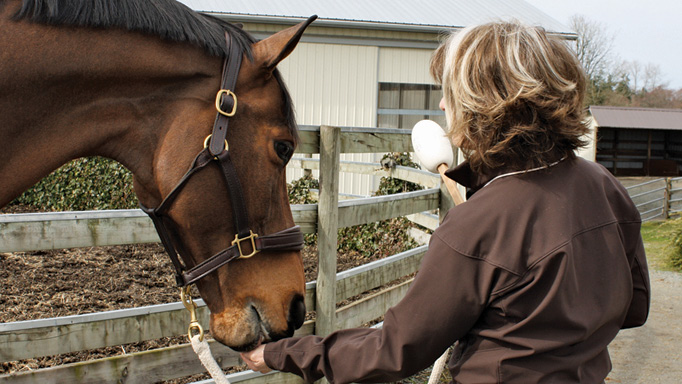Young horses generally do not bite out of maliciousness, but rather playfulness. Horses play with each other with their teeth and hooves, and young horses have not yet learned that playing with humans similarly is not on the agenda. Youngsters need to learn where their space ends and yours begins, and that entry into your space is by invitation only. If the horse is not in your space, he is not in a position to bite you.
Positive reinforcement training is an effective tool to train this and similar ground manners. It teaches your horse that interacting with humans is good news, making the transition to under-saddle easy and natural. It is hard to mess up even for non-professionals. And, it is fun.
Positive reinforcement simply means that behaviours that are followed by a reward are strengthened – i.e. they are likely to reoccur (for more details see Horse Sport article here). To teach my horse not to bite me, I reward him for not biting me, and thus let him know that not biting is the behaviour I want to see again. There is a well-established myth that is a poor idea to give horses treats because it makes them nippy. However, treats do not make nippy horses unless the horse is reinforced for nipping. In fact, treats can teach your horse not to be nippy.
When teaching young horses with positive reinforcement training, the first lesson is not to maul me for the treats that I am carrying with me in a pocket or pouch. Generally, I begin this with a clicker (a small hand-held device that makes a distinctive clicking sound). If the sound of a click is always followed by a treat, the clicker will soon become associated with the notion that good things will follow. Although not absolutely necessary, the clicker fine-tunes the training by alerting the horse to the precise behaviour I want to reward.
If he mauls me for treats, I ignore this behaviour, or if necessary, push him away. Any movement away from the treat source is immediately rewarded with a click followed by a treat. Very soon, he understands that mauling me does not get him anywhere, keeping out of my space brings good things, and that the sound of a clicker is a very good thing indeed.
After the horse has learned the my space/your space lesson, leading him out to his turn-out is the next good place to practice; the temptation to bite will be greater as your exuberant youngster anticipates his playing time outside. If he happens to walk quietly beside you, immediately reward this behaviour. The treat or positive reinforcement lets him know that this is the behaviour you want. At the first sign of him pushing into your space, push him away (you may need a crop or a chain over his nose to correct his position); when he is back in his space for a step, reward this behaviour.
Horses, like humans, do what works and they stop doing what doesn’t work. If you don’t want your horse to bite, make sure that biting does not work, and that not biting does. It really is almost that simple.

